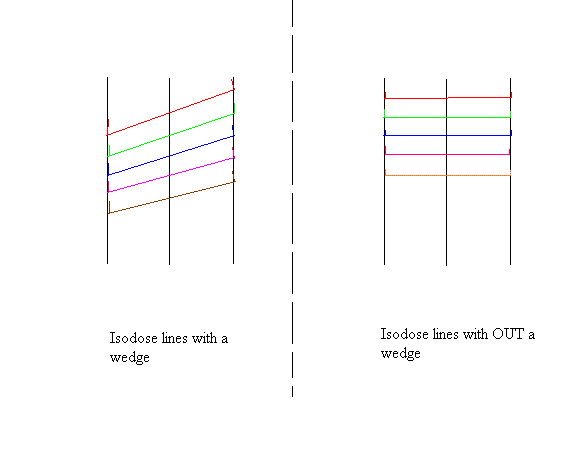 Brain Teaser #6
Brain Teaser #6
A) Question:
Can a wedge be used as a compensator?
A) Answer:
Yes, a wedge can be used as a compensator.
B) Question:
If treating AP/PA lung fields and a wedge, which is being used as a compensator, is required for the AP field, which anatomical direction would you expect the heel to be oriented?
B) Answer:
Usually you expect the heel of the wedge to be oriented superiorly.
Follow Up:
The heel of the wedge is usually oriented superiorly because the heel will make up for the lack of tissue missing in the superior plane of an AP lung field.
C) Question:
How is the wedge angle usually defined?
C) Answer:
The wedge angle is defined as the angle in which an isodose curve is tilted relative to the central axis of the beam at a specific depth, usually 10 cm. It is NOT the physical angle of the wedge.

D) Question:
In a wedge pair plan, are heels usually together or are the heels of the wedge usually apart?
D) Answer:
The heels of the wedges are usually together. Remember this saying, heels together, toes apart.
E) Question:
You have a wedged pair plan that utilizes a pair of 30 degree wedges are used. In an "Ideal" patient, what would you expect your hinge angle to be?
E) Answer:
You would expect the hinge angle to be 120 degrees.
F) Question:
If you have a hinge angle of 90 degrees, what wedge angle would you expect to be used for each of the wedges in the wedge pair?
F) Answer:
You would expect to use a wedge pair with 45 degree wedges.
Follow Up:
The goal of a wedge pair is to have everything add up to 180 degrees. Your hinge anlge is defined as the angle in between the two wedges. So you can use the following equation:
If you are missing either the wedge angle or the hinge angle, put an x for the variable you are missing, and solve for x.
G) Question:
As the hinge angle increases does the required wedge angle usually increase, decrease, or remain the same?
G) Answer:
As the hinge angle increases the degree of wedge angle required usually decreases.
H) Question:
You are treating a four field pelvis where 30 degree wedges are required on both laterals, according to the plan. One day during treatment, you forget to put in the wedges on both laterals. The wedge factor is .693. Assume equal weighting for all 4 fields at 180 cGy per day. For ONE of the laterals, what was the actual dose you delivered that day, since you forgot the wedge?
H) Answer:
On ONE of the laterals you would have delivered 65 cGy.
Follow Up:
You know that it is equal weighting, therefore you are supposed to deliver 45 cGy to one of the laterals, Simply take 45 cGy and divided it by your wedge factor .693
I) Question:
You are treating a four field pelvis where 30 degree wedges are required on both laterals according to the plan. One day during treatment you forget to put in the wedges on both laterals. The wedge factor is .693. Assume equal weighting for all 4 fields at 180 cGy per day. What would be the TOTAL dose you delivered for that one day.
I) Answer:
You would have delivered for that one day 220 cGy.
Follow Up:
You know that for the AP and PA 45 cGy was delivered to both fields (it was treated correctly), and you gave 65 cGy to both laterals. So, take
45+45+65+65 = 220 cGy
J) Question:
What was your percent in error if you were supposed to deliver 180 cGy but gave 220 cGy?
J) Answer:
Your percent in error was 22.2 %
Follow Up:
--------------------------------------------- X100
accepted
180 cGy - 220cGy
--------------------------------------------- X100
180 cGy
When subtracting even though you get a negative number, just ignore the negative number and make it positive since it is a percent.
THE END
Author: Adam Buell
Editors: Mary Hare
Date Created: May 2005


